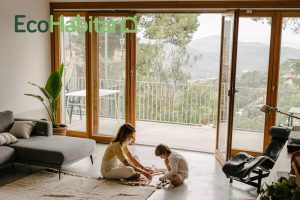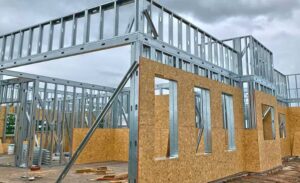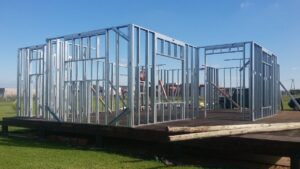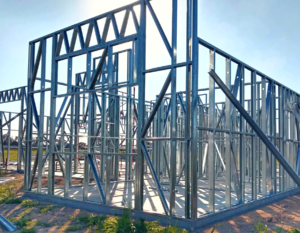In the construction world, two types of methods compete for supremacy: the Steel Framing System and wet construction. Each has its own strengths and weaknesses, and the choice between them depends on the specific needs of each project.
What’s the battle about?
Steel Framing is characterized by its speed of construction, energy efficiency, and superior acoustic insulation. On the other hand, wet construction is the region’s traditional building system, with a larger available labor force.
To answer the question, let’s analyze each point in detail:
- Speed of Execution
Steel Framing stands out for its speed, outperforming wet construction by 30% to 60%. This advantage comes from prefabrication of components in the workshop, which allows work to proceed independently of weather conditions. Additionally, the absence of curing times and wet mixtures significantly speeds up construction.
Who benefits?
- Construction companies: Optimize execution times, reduce costs, and increase productivity.
- Investors: Gain earlier access to their projects, generating quicker returns on investment.
- End users: Enjoy their homes or commercial spaces in less time.
- Energy Efficiency
Both Steel Framing and wet construction can achieve high levels of energy efficiency if the proper materials and techniques are used. The key lies in thermal insulation, and both systems offer effective solutions to reduce energy consumption and create comfortable environments.
This benefits the environment by minimizing impact through reduced energy use and CO2 emissions. End users also enjoy greater thermal comfort and savings on heating and cooling.
The difference lies in wall thickness: Steel Framing allows thinner walls without sacrificing insulation, resulting in more usable floor space.
- Acoustic Insulation
Dry construction systems like Steel Framing achieve superior acoustic insulation thanks to their layered configuration (panels, insulation, panels) compared to the solid masonry used in wet construction. A properly insulated lightweight Steel Framing wall can achieve 70% more acoustic insulation than a brick wall (which is four times heavier). - Structural Safety
Steel Framing structures, made of lightweight metal profiles, offer structural safety comparable to wet construction. Their calculations follow the guidelines of the current CIRSOC and INPRES CIRSOC regulations, the same used for wet construction structures. Submitting a calculation report is sufficient to verify the safety of steel structures in Steel Framing. - Cleanliness and Waste
Wet construction, using materials such as cement, lime, and aggregates, generates more dirt and waste during the process. Steel Framing produces much less waste since its main components, galvanized steel profiles, can be ordered cut to the exact lengths needed for each project. - Remodeling and Extensions
Remodeling or extending Steel Framing buildings is simple, fast, and clean since there is no need to break walls or generate debris. Wet construction causes more inconvenience and mess to owners, producing large amounts of waste and dirt. Steel Framing allows quick and easy adaptation of homes to new functions, according to residents’ desires or changes in family size. - Durability
The durability of both construction systems, when properly executed, is long-lasting and similar. Steel Framing profiles have a zinc coating that ensures durability over 200 years, even in aggressive environments (such as coastal areas), provided waterproofing requirements are met. Numerous constructions over 100 years old in Ushuaia demonstrate this. - Repair Costs
Repair costs in Steel Framing systems are significantly lower than in wet construction. This is due to easy and immediate access to installations, avoiding wall breakage and the use of wet materials that require long drying times before painting.
For example, repairing a broken pipe in a Steel Framing house is straightforward: the leak is detected by moisture evidence on the panel, only the wet section is cut out, the leak repaired, and the panel replaced in that spot. No debris, faster repairs.
Choosing between Steel Framing and wet construction for your next project means evaluating the specific needs and priorities involved.
If you seek a fast, efficient build with excellent acoustic insulation, safety, cleanliness, flexibility, and lower repair costs, Steel Framing is an excellent option. If you value tradition and proven experience, wet construction may be the better choice.
In any case, it is essential to consult construction professionals for a personalized assessment to ensure your project’s success.
Remember that both systems—Steel Framing and wet construction—can deliver excellent results when executed properly and with high-quality materials.





